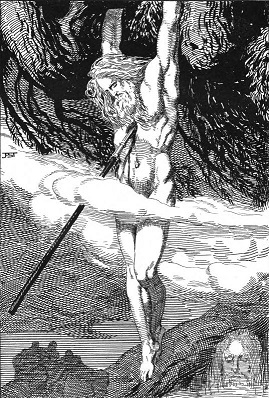It is odd that the
Vikings, who worshiped a pantheon of mostly war gods would convert to a
religion based on forgiveness and peace, but there is a surprising amount of overlap
between the myths of the Aesir and the story of Christ. First, there is a heavy
emphasis on martyrdom and self-sacrifice. Odin sacrifices one of his eyes to
gain knowledge of the future so he can avert Ragnarok, and Tyr loses one of his
hands to imprison the wolf Fenrir. Jesus creates wine and bread for the poor
out of his blood and body, respectively. Next, both Odin and Jesus achieve
apotheosis by sacrificing their own lives. Odin hangs himself on the world tree
Yggdrasil for 9 full days, and gains knowledge about magic runes, charms, and
information about the other gods. He then shares his magic and wisdom with
mankind. After dying on the cross, Jesus resurrects and ascends to Heaven. In
addition, they are both impaled in some way. Odin has his side pierced with his
own spear, and Jesus by the infamous Spear of Destiny, as well as the nails and
the crown of thorns. What they were martyred on is also important. There is a
concept called the axis mundi, a “world pillar” that is the center of the
planet and connects heaven and earth. The world tree Yggdrasil is a clear
example. Trees are rooted in the ground and reach towards the sky. In the case
of Jesus, his body on the wooden cross is the axis, acting as the bridge
connecting God to humanity.
Considering that the sagas were written after
Christianization, I think the reason Iceland was open to conversion at this
time was that the country was in the middle of a decades-long blood feud which
affected nearly every family. Lots of people were being killed for petty offenses,
which probably had nothing to do with them and were committed long ago. I think
the idea of a god of atonement who forgave people and wiped away their sins
would have been very attractive to Icelanders. Especially since they were
phasing out of the Viking raider mindset and were settling down as farmers.
Getting into Valhalla through bravery on the battlefield was not as likely at
that point.

I really enjoyed reading the multi symbolic comparisons you made in describing Odin and Jesus. This is not exactly a comparison I would have put together before taking a class on Vikings. I believe in reading American Gods the concepts of magic and gods traveling around in our world as regular people really breaks the boundaries of how we view power. Because we have been reading this, I think it is perfectly logical to compare the similarities between Odin and Jesus. I did not have as much background knowledge on Odin before so pointing out the specific details in the way both were murdered was very eye-opening.
ReplyDeleteVery interesting comparison, between Odin and Jesus, and various of other folklore. Your blog was interesting to read, as examples of Odin and Jesus giving their knowledge to tothers, as well as scarifying their own flesh for others, with similar deaths. As well as both Odin, and Gandalf being masters of wisdom and disguises. I was caught off guard with more accounts on what Odin did. With the inclusion of Christianity spreading through the Nordic region during when the literature was finally being written, even backs up the case, and gives more evidence for a more central figure in the Nordic polytheistic culture, like as Christianity does.
ReplyDeleteI really liked your comparison between Odin and Jesus' martyrdom here. I think it's fitting and not something I thought about before. Odin, in my eyes, was always someone who was like… the antithesis to Jesus, in some ways, so this blog post really opened my eyes. To me, because of Odin’s trickster ways, and how he condones and supports raids and violence, it seemed very antithetical to Christian values. Jesus always tended to the weary, sacrificing himself for others, while Odin seemed to sacrifice himself for… himself. So he could be more powerful. But I don’t know, I think considering them as similar also works.
ReplyDeleteGreat blog. Very interesting topic for sure, and I liked how you compared Odin and Jesus and brought to mind the social context of the time. Gandalf as a representation of Odin is also very interesting, especially since Tolkien was a strong Christian, and Gandalf seems to be sort of a combination of Jesus and Odin. Gandalf has Odin-like qualities, like you said, and also has many Jesus-like qualities as well (coming back from the dead, self sacrifice, miracles, wisdom, etc.).
ReplyDelete